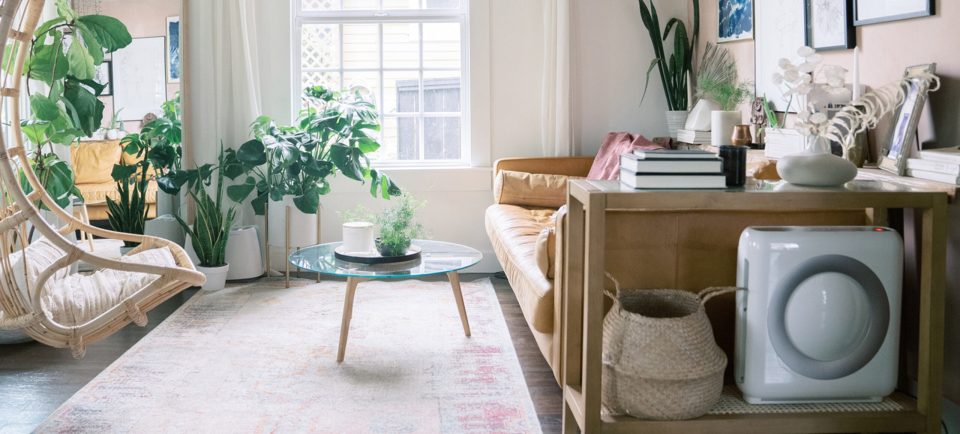In 2020, against the backdrop of a pandemic that made folks increasingly concerned about germs swirling in their homes and wildfires ablaze in a number of regions that compromised the air quality in their path of destruction, air purifiers saw market growth of 57 percent, according to research by the consulting firm Verify Markets. And that growth is only expected to continue with the worldwide air quality monitoring system industry predicted to reach $5.9 billion by 2026, up from $4.4 billion in 2021. Alongside this rise in popularity of air purifiers comes new tracking technology housed within the products, which means we’ll soon be monitoring air quality the way we’ve long used fitness trackers for personal health metrics.
“The sensor market hasn't changed for probably 20, 30 years,” says Ray Wu, CEO and founder of air quality brand Wynd. “The only data that you get about the air is the temperature...but there's so many other parameters such as particulate matter, chemicals, odors, the ventilation state, mold, pollen—those things [traditionally did not] get captured.” The new wave of indoor air quality products allow home metrics to get more specific.
Alongside the rise in popularity of air purifiers comes new tracking technology housed within the products, which means we’ll soon be monitoring air quality the way we’ve long used fitness trackers for personal health metrics.
In November 2021, Dyson and Coway launched updated versions of their app-connected air purifiers, which keep tabs on your air quality (and send reports to your phone) and adjust air flow as needed. Levoit is set to follow suit with its latest app-connected smart air purifier in January.
We can also expect to see innovation from air quality monitors in the coming months. Independent of an air purifier, Amazon is launching its own Smart Air Quality Monitor on December 8, which connects to the Alexa app and allows users to track and measure particulate matter, volatile organic compounds, carbon monoxide, humidity, and temperature.
Wynd, the maker of the Halo & Max Purifier Bundle (which features a monitor separate from the purifier to allow the machine to respond to air quality changes where people are as opposed to in the corner where purifier lives) plans to release products in 2022 that provide user recommendations based on air quality readings and connect to a home’s HVAC system to efficiency bring in fresh air when it’s needed. The company received $10 million in Series A funding in August 2021 to expand its business-grade air-quality solutions.
“Just because you haven't had a car accident, you still wear your seatbelt and have car insurance. So just because there hasn't been a negative [outcome of poor air quality] doesn't mean you shouldn’t be aware and be continuously monitoring the issue.” John McKeon, MD, CEO of Allergy Standards
In November, air-quality monitor brand Airthings launched View Plus, a thermostat-sized, battery-powered air-quality monitor that goes a step beyond tracking to provide recommendations based on its findings. For example, if View Plus senses that your humidity levels are prime for mold growth, you’ll get personalized suggestions from the companion app on your phone, ranging from just cracking a window, to raising the temperature, to investing in a dehumidifier, depending on what it senses that you need. “It's typically small things we can do that make a big change,” says Oyvind Birkenes, CEO of Airthings. Because your indoor air quality can change dramatically throughout the year, having constant monitoring and recommendations allows you to keep your air quality optimized.
This metric-meets-advice formula is stretching beyond indoor air and onto surfaces. In September 2021, Scotch-Brite launched the Clean Scan, the world’s first consumer home cleaning efficacy test. It comes with swabs for you to collect samples from various surfaces in your kitchen and bathroom before and after cleaning. Scotch-Brite analyzes the swabs using polymerase-chain-reaction (PCR—sound familiar?) tests, asks you a few questions about your cleaning routine, and provides data showing how effective it is. “We're trying to make the invisible visible,” says Kim Tsujimoto, PhD, vice president and technical director of the Global Home Care Division of 3M, which includes Scotch-Brite. If the Clean Scan test doesn’t show a substantial reduction of bacteria (or worse, an increase) after cleaning, Scotch-Brite will provide tips, like more frequent cleaning or swapping out cleaning tools more regularly.
Dr. Tsujimoto says 3M will continue exploring this data-driven feedback-metric space into 2022 and beyond. And Birkenes says Airthings plans to launch additional trackers next year, as well. With this slate of launches will come wider access to home health metrics. And that’s great because the information provides people with intel to make whatever changes necessary to preserve the health of their space.
“Just because you haven't had a car accident, you still wear your seatbelt and have car insurance. So just because there hasn't been a negative [outcome of poor air quality] doesn't mean you shouldn’t be aware and be continuously monitoring the issue,” says John McKeon, MD, CEO of Allergy Standards, a company that certifies products like air purifiers as allergy and asthma friendly. “These trends, like people being switched on to air quality, they're going to persist. These aren't short-term trends.”

